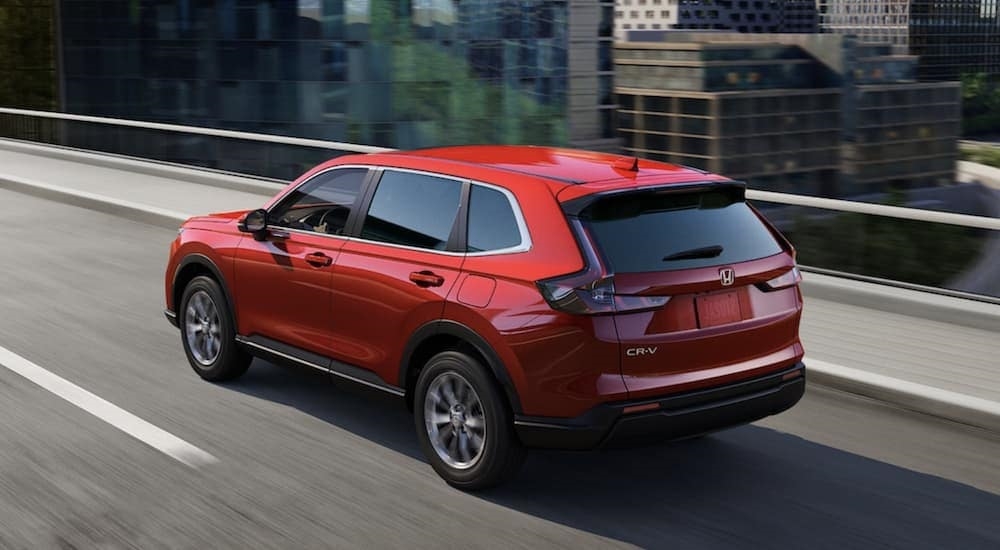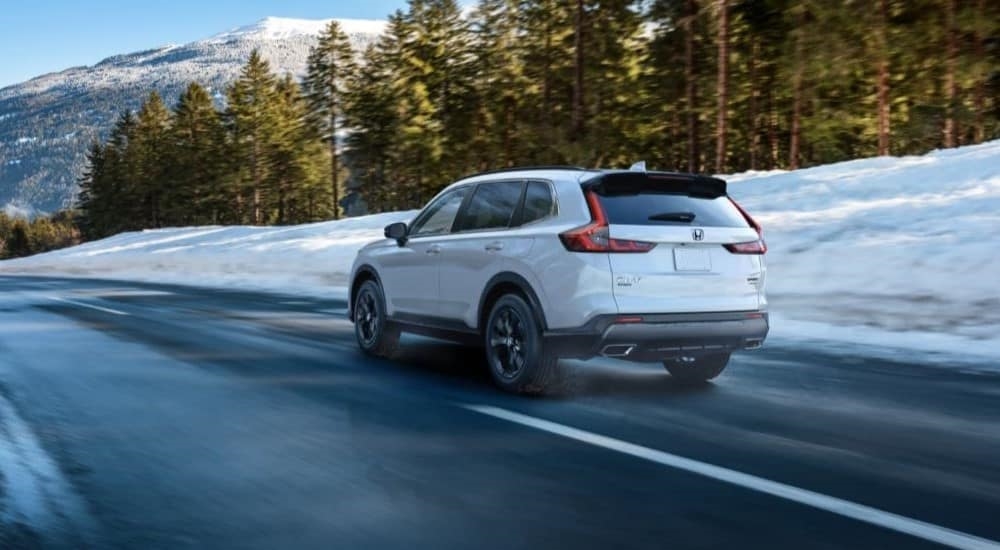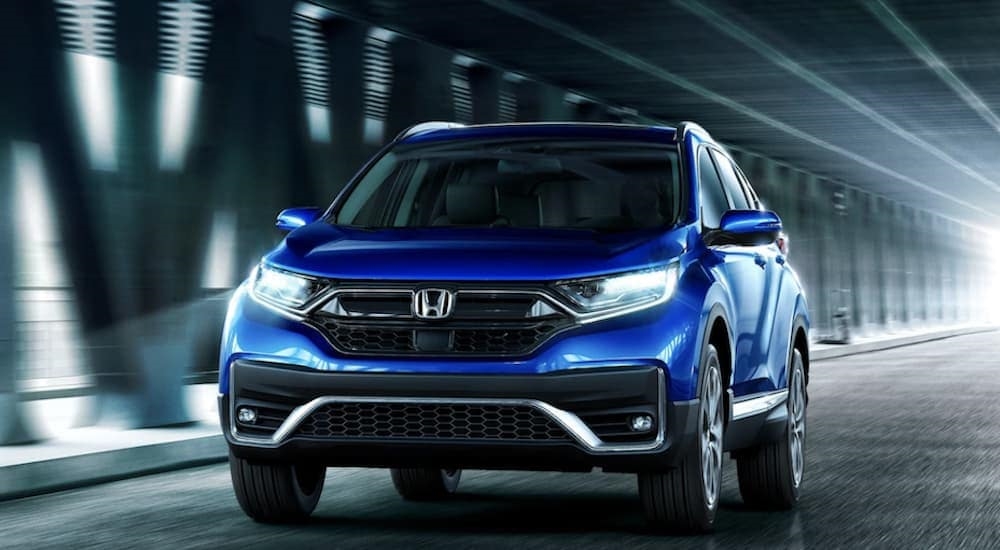
You’ll experience this no-compromise approach in the Honda lineup, particularly with models like the compact CR-V, at dealerships like ours. Make Klein Honda the first stop in your journey to get behind the wheel of a Honda CR-V for sale near Bellevue, WA. But what makes the CR-V perfect for Bellevue drivers? That’s a question we’re thrilled to answer as we dive into everything you’ll love and appreciate about Honda’s compact SUV!
#1 – It Started a New Trend
Honda secured its position on American soil with sedans like the Civic and Accord, solidifying its reputation for building practical vehicles. By the late 1990s, Honda returned to the drawing board to answer a new demand in the industry for more versatility and functionality. Honda’s response officially debuted in America as the 1997 CR-V. Formally known as the “Comfortable Runabout Vehicle,” the CR-V was a new concept in the American automotive landscape. It was impossible to categorize because it wasn’t a sedan or an SUV, despite sharing characteristics of both.
The CR-V joined rivals like the Toyota RAV4 to establish a new class of vehicles known as crossover SUVs. Smaller than the land yachts that defined the SUV segment in the 1990s, the CR-V’s compact footprint gave it an advantage, enhancing its agility and efficiency without compromising ride quality or passenger and cargo capacity. Suddenly, drivers had the best of both worlds.
#2 – It’s Always Been Unique
The CR-V established a new segment in the late 1990s but also introduced other unique features that added to its appeal. Where rivals were happy to follow trends, Honda defied convention and did everything possible to differentiate the CR-V from older truck-based SUVs. For example, the first-generation CR-V was built on the Civic’s platform, meaning its cabin floor was flat. As a result, the CR-V’s cabin was more spacious and accessible, which Honda complemented by keeping the area between the front seats open. At the rear, the flat floor made loading cargo easier and doubled as a picnic table to appeal to the more adventurous, giving the CR-V another fun feature. Can you name any other SUV with a picnic table on board?
#3 – It’s Constantly Evolving
Honda is keenly aware of driver needs and responds by frequently updating models like the CR-V to meet those needs and exceed expectations. We see this in the CR-V’s expanding footprint over the years. Its first growth spurt occurred with its second-generation debut in the new millennium. Honda stretched its platform to make the interior more spacious and added multi-way folding seats to increase functionality and accessibility.
The 2023 CR-V marks this SUV’s sixth generation and introduces another significant expansion that translates to a better user experience for the driver and passengers. Honda broadened the CR-V by 0.4 inches and stretched its length by 2.7 inches to give it a sleeker, more sophisticated silhouette. This growth also impacts the cabin, which increases legroom and cargo capacity to an all-time high. Additionally, Honda complements this growth spurt by moving the A-pillars and mounting the side mirrors lower on the doors, improving outward visibility and highlighting the airy and modern design of the cabin.
The CR-V’s latest redesign makes it even more appealing to Bellevue drivers because it offers more room without compromising its performance, handling, or sophisticated styling. With incremental growth, the CR-V maintains its on-road manners but capitalizes on its versatility by readily accommodating passengers and cargo. As a result, it’s the perfect SUV to navigate your commute into Seattle, run errands around town, or explore the wonders of Mount Rainier National Park on the weekend.
#4 – It Redefines Functionality
The Honda CR-V has marched to the beat of its own drum since its debut in 1997 when drivers never fathomed having a picnic table always on hand. While the picnic table eventually faded into oblivion, the CR-V has never lost sight of what it does best––redefining functionality. Honda’s lineup includes plenty of practicality and versatility, but there’s no better example of this than the 2023 CR-V.
The sixth-generation CR-V is the most functional and versatile version yet, which we attribute to its recent redesign and expanded footprint. By widening its stance and stretching its length, the 2023 CR-V debuts with the largest cargo capacity in CR-V history at 36.3 cu.ft. behind the rear seats. However, even this isn’t enough for Honda. Instead, the automaker pushes the CR-V’s capacity even further on trims like the EX and EX-L, which have a load floor that you can lower to expand the SUV’s cargo capacity to 39.3 cu.ft.
When you’re not using the second row, you can take advantage of the 60/40 split-folding rear seats to expand the cargo space to 76.5 cu.ft. Moreover, the CR-V includes many other functional features, like the voluminous center console that gives you nine liters of storage space. You’ll also find the CR-V’s lower liftover height makes accessing cargo easier, while the powered hands-free tailgate adds convenience when your hands are full.
#5 – It’s Tech-Savvy
Technology was vastly different in the late 1990s before smartphones gained momentum in the new millennium by promising to keep us connected beyond our offices and homes. Back then, integrating this technology into our vehicles was unimaginable, and models like the 2001 CR-V prove as much. Innovative for the time, the 2001 CR-V was considered incredibly well-equipped because it came with a high-capacity air conditioner with a built-in air filter, power windows and doors, cruise control, and an AM/FM radio. That’s it.
As our reliance on smartphones has progressed, automotive-related connectivity features have followed suit. Honda quickly adopted new technology, introducing Bluetooth capability to CR-V drivers and continuously expanding that technology to include more tools. Today, this technology looks vastly different in models like the 2023 CR-V, which comes with a standard digital instrument cluster and a seven-inch or nine-inch color touchscreen with Apple CarPlay and Android Auto integration. In addition, top-tier trims like the EX-L and Sport Touring raise the ante by adding wireless smartphone integration and charging, features unimaginable to drivers in the late 1990s.
#6 – It’s Always Made Safety a Priority
Honda’s desire to build reliable, long-lasting vehicles is innately tied to its efforts to prioritize driver and passenger safety. We see this with every iteration of the CR-V, from its first to its sixth generation. However, the delivery is dramatically different and showcases advancements in the industry over the years. How so?
The 2001 CR-V included basic safety features like rigid construction, a reinforced steering column, three-point seatbelts, and available anti-lock brakes. These components and other design elements, like stiffening the rocker panels and roof side rails, guaranteed the CR-V met federal standards that assured it could withstand frontal, side, or rear impacts at 30 mph. However, while impressive at the time, the 2001 CR-V pales compared to the 2023 CR-V, which introduces a stiffer body construction, updated Honda Architecture, and an expansion of the Honda Sensing suite.
In 2001, the CR-V’s safety and driver-assist features were limited to body structure and tools like cruise control. Fast forward two decades, and the experience is quite different, thanks to tech-savvy features like Honda Sensing. The 2023 CR-V introduces more tech than ever, including Traffic Jam Assist, Traffic Sign Recognition, Low-Speed Braking Control, Adaptive Cruise Control, a Lane Keeping Assist System, and a Blind Spot Information System. These tools complement the CR-V’s passive safety features, like the front knee airbags, rear seat side-impact airbags, and next-generation driver and passenger airbags.
The Power of the Honda Name
Bellevue drivers appreciate any opportunity to get behind the wheel and genuinely enjoy the drive. The Washington landscape is breathtaking, even more so when you’re in the driver’s seat of a versatile model like the Honda CR-V that never requires you to compromise. The CR-V carries the reliability of the Honda name, adding appeal by adapting to all your driving needs. It can take you into downtown Bellevue or across Lake Washington into Seattle for work just as readily as it can travel south to Tacoma or along I-5 to Portland for an unforgettable adventure with your family.


